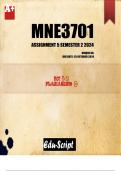MNE3701
ASSIGNMENT 5 SEMESTER 2 2024
UNIQUE NO.
DUE DATE: 25 OCTOBER 2024
, Question 1
Managing Business Assets: A Practical Approach
In managing the assets of any business, it is crucial to adopt strategies that ensure
sustainability, efficiency, and profitability. For the purpose of this discussion, I envision
starting a boutique clothing store that focuses on eco-friendly and locally sourced
fashion items. The key assets in this business will include inventory, equipment,
intellectual property (IP), and financial resources. Managing these assets effectively will
involve a combination of strategic planning, control measures, and leveraging modern
technologies.
1. Inventory Management
Inventory forms the backbone of a retail business, and managing it effectively is crucial
to avoid excess stock or shortages. I would implement Just-in-Time (JIT) inventory
management, which ensures that stock is ordered and received only when it is needed
for sales, reducing the costs of storage and obsolescence (Jones, 2019). For example,
instead of holding large quantities of every item, I would analyze customer preferences
using point-of-sale data to stock only what is in high demand, ensuring optimal
turnover and minimizing waste. By leveraging technology, such as inventory
management software, I would maintain real-time visibility of stock levels and automate
reordering processes.
2. Equipment Management
The second major asset for my business will be equipment, including display racks,
sewing machines (for custom tailoring services), and point-of-sale (POS) systems.
Regular preventive maintenance would be employed to ensure that these assets
remain functional and efficient. For example, I would establish a maintenance schedule
for sewing machines to avoid breakdowns that could disrupt business operations.




